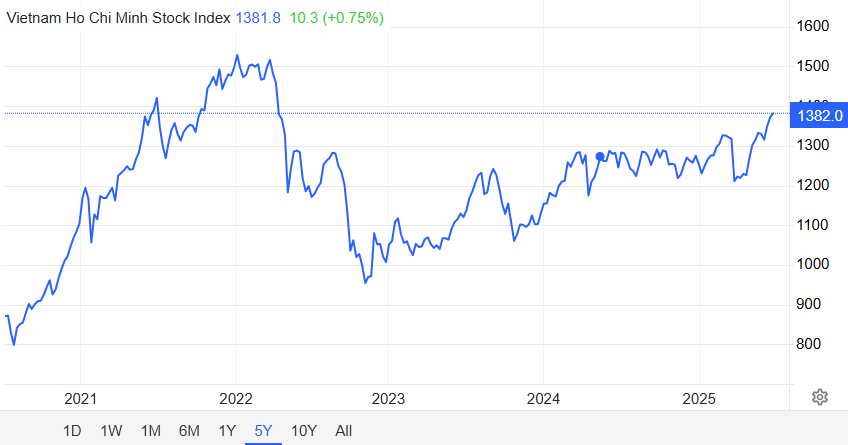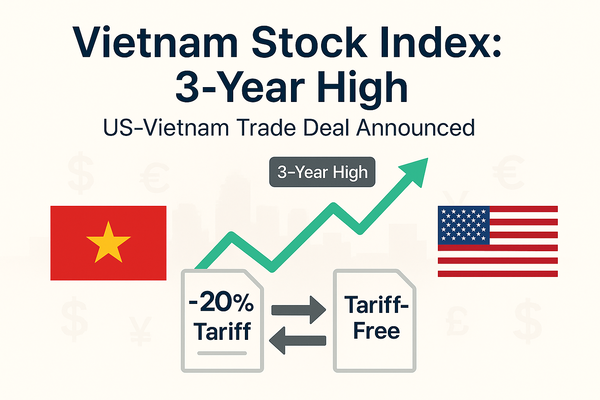Vietnam's stock market surged to its highest level since April 2022 after President Trump announced a new US-Vietnam trade agreement, sending the benchmark VN-Index close to the 1,400 mark.
The deal, revealed on 2 July 2025, imposes a 20% tariff on Vietnamese exports to the US but grants tariff-free access for American goods entering Vietnam. The news has energised Vietnamese equities, with the VN-Index climbing for a fifth consecutive session and investor optimism running high.
Vietnam Stock Index Nears 1,400 After US Tariff News

The VN-Index, which tracks the Ho Chi Minh Stock Exchange, added nearly 4 points at the open on 3 July, reaching close to 1,390. This follows a strong rally on 2 July, when the index closed at its daily high after jumping nearly 7 points, supported by robust trading volumes and broad-based sector gains. Liquidity on the exchange surpassed VND 5,400 billion (about USD 212 million) by mid-morning, highlighting renewed investor interest.
Key sectors driving the advance included banking, consumer goods, retail, and energy. Notable gainers were Vinhomes (VHM), up VND 800 to VND 76,800 per share, Mobile World (MWG), up VND 1,100 to VND 65,900, and Masan (MSN), up VND 400 to VND 75,600. Securities stocks also surged, with an average increase of 4.3% across the sector.
US-Vietnam Trade Deal Details
On 2 July, President Trump announced the United States would impose a 20% tariff on Vietnamese exports, a rate lower than the previously threatened 46% but still a significant increase from the 10% temporary rate that had been in place. Goods transshipped through Vietnam, such as those originating in China, will face a 40% tariff. In exchange, Vietnam will grant US goods tariff-free access, a first in the two countries' trade relationship.
The deal comes just days before a 90-day moratorium on reciprocal tariffs was set to expire. Without a new agreement, tariffs on Vietnamese goods would have reverted to the higher 46% rate.
The agreement is seen as a political win for both sides: the US secures greater market access for its exports, while Vietnam avoids the most punishing tariff scenario and maintains strong ties with its largest export market.
Market Reaction and Economic Impact
The announcement triggered a surge in Vietnamese equities, with the VN-Index reaching its highest point in over three years. Analysts note that Vietnam's economy, which relies on exports to the US for about 30% of its GDP, is particularly sensitive to tariff changes.
The new 20% tariff, while less severe than the previously proposed 46%, will still raise costs for US importers and could impact consumer prices on goods such as apparel and electronics.
Retail consultancy AlixPartners estimates the new tariff could raise the price of an imported men's sweater by 8%, compared to a 35% increase under the original 46% rate. US companies with significant manufacturing footprints in Vietnam, including Nike and Under Armour, saw their shares rise on the news, reflecting relief that the tariff rate was not as high as initially feared.
Outlook for the VN-Index

Brokerage forecasts suggest the VN-Index could reach 1,400–1,420 in 2025, driven by expectations of 18% market-wide profit growth and a price-to-earnings ratio of 12.5–13x.
Vietnam's economic outlook remains robust, with anticipated GDP growth of 7–7.5% over the next three years and exports projected to rise by 9–10% in 2025. The trade deal is expected to support these targets by sustaining export momentum and attracting further foreign investment.
However, some analysts caution that the deal may provoke new tensions between Washington and Beijing, as the US aims to crack down on transshipped goods and maintain pressure on Chinese supply chains. The full implementation details of the agreement, particularly regarding transshipment rules, remain to be finalised.
Conclusion
Vietnam's stock market has responded positively to the US-Vietnam trade agreement, with the VN-Index climbing close to the symbolic 1,400 level for the first time since April 2022.
While the 20% tariff introduces new costs for US importers, the avoidance of a steeper 46% rate and the opening of Vietnam's market to US goods have been welcomed by investors. As the deal takes effect, market participants will be watching for further details and potential ripple effects across the region.
Disclaimer: This material is for general information purposes only and is not intended as (and should not be considered to be) financial, investment or other advice on which reliance should be placed. No opinion given in the material constitutes a recommendation by EBC or the author that any particular investment, security, transaction or investment strategy is suitable for any specific person.


























